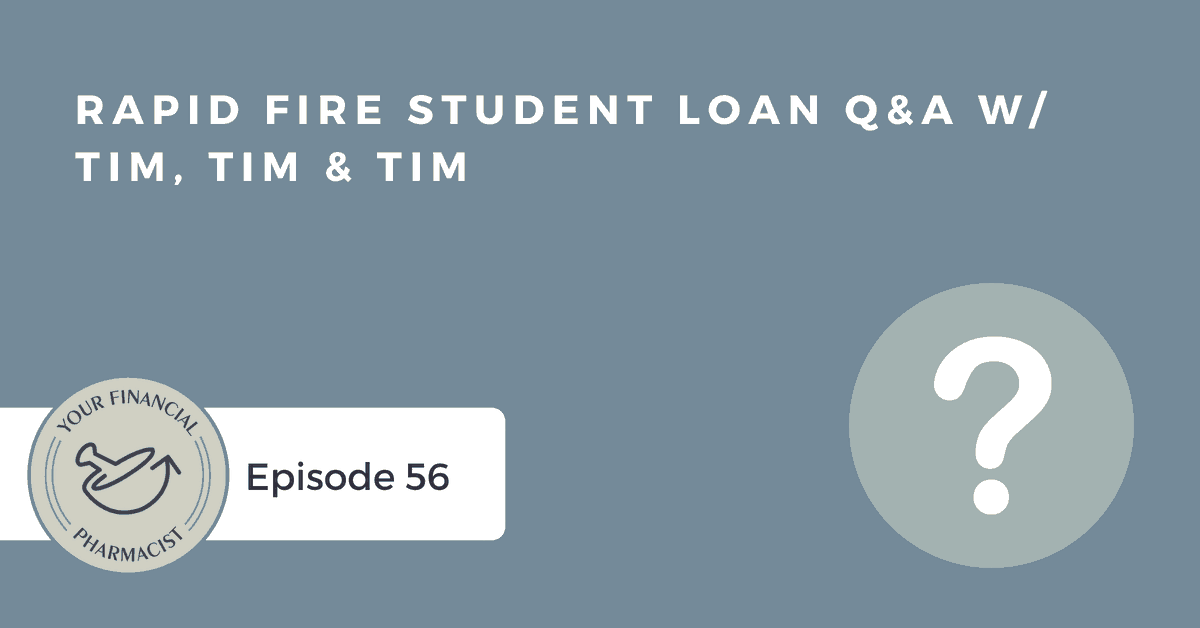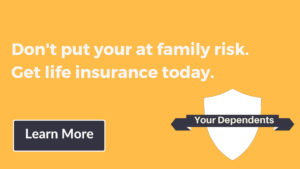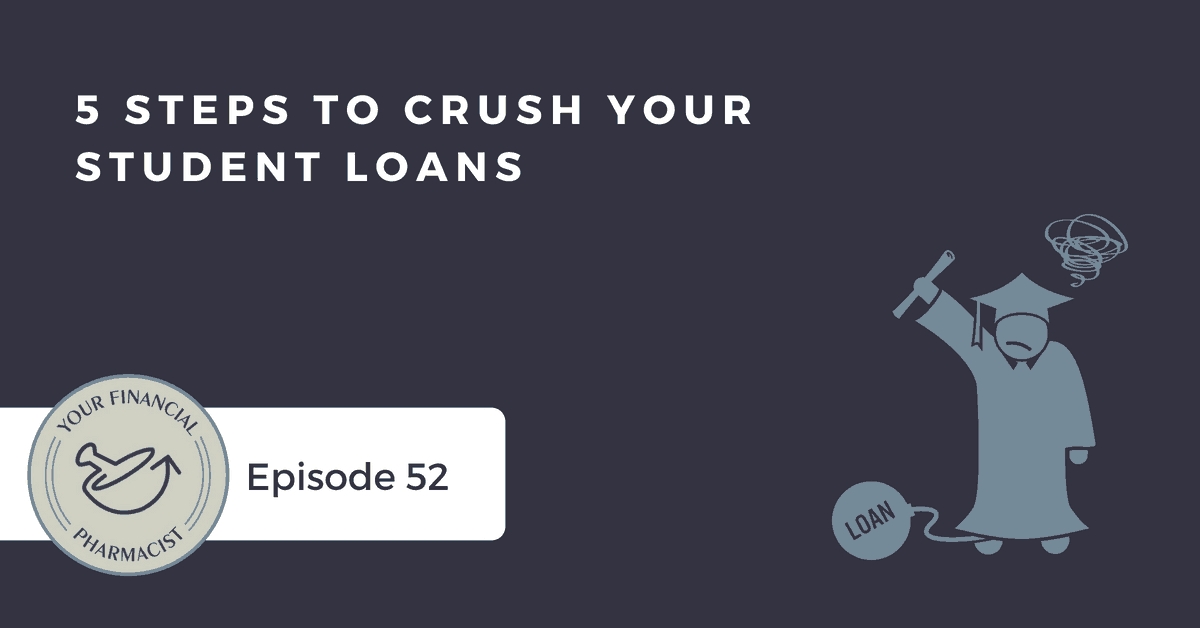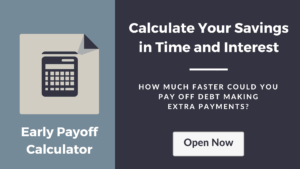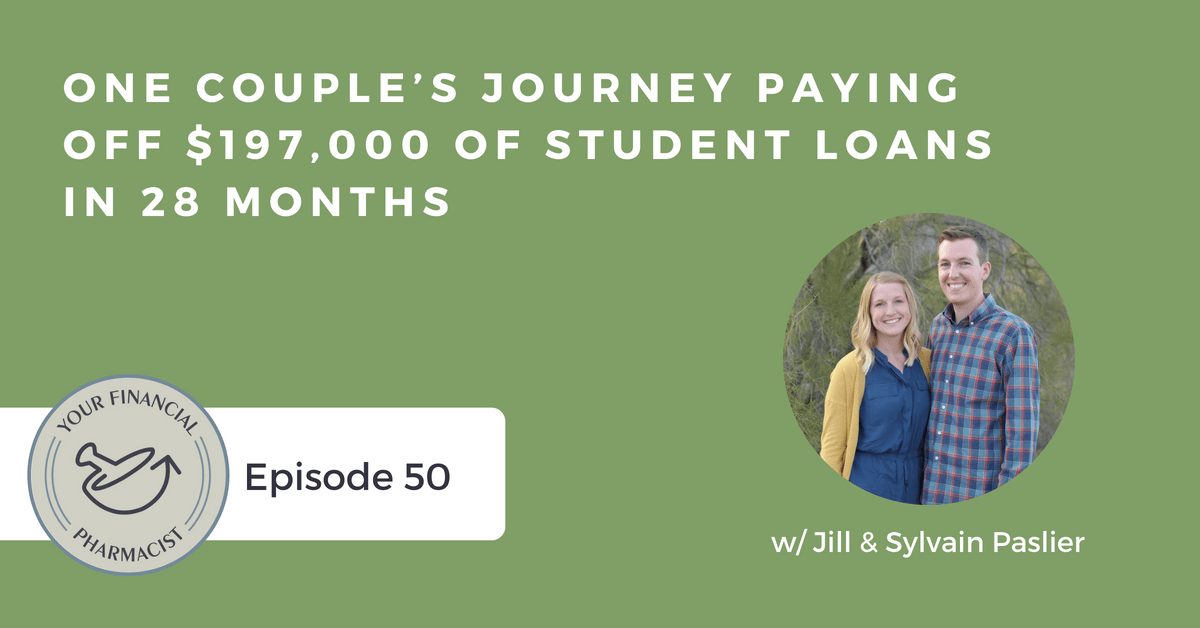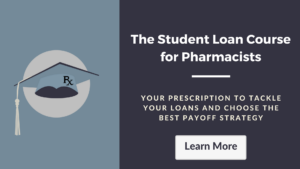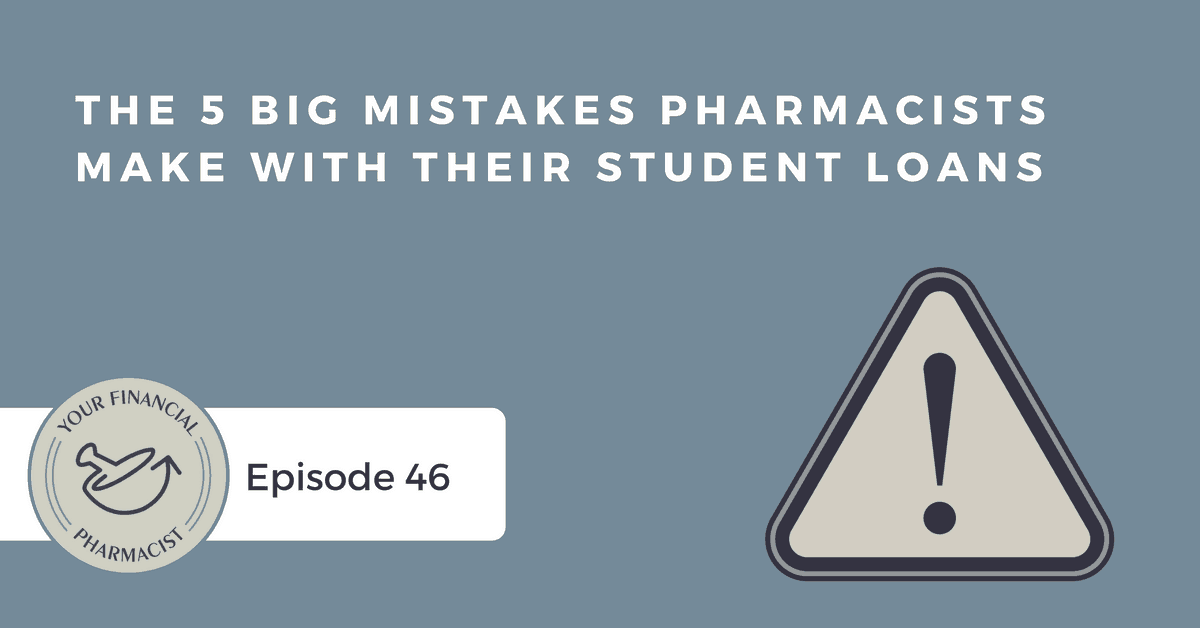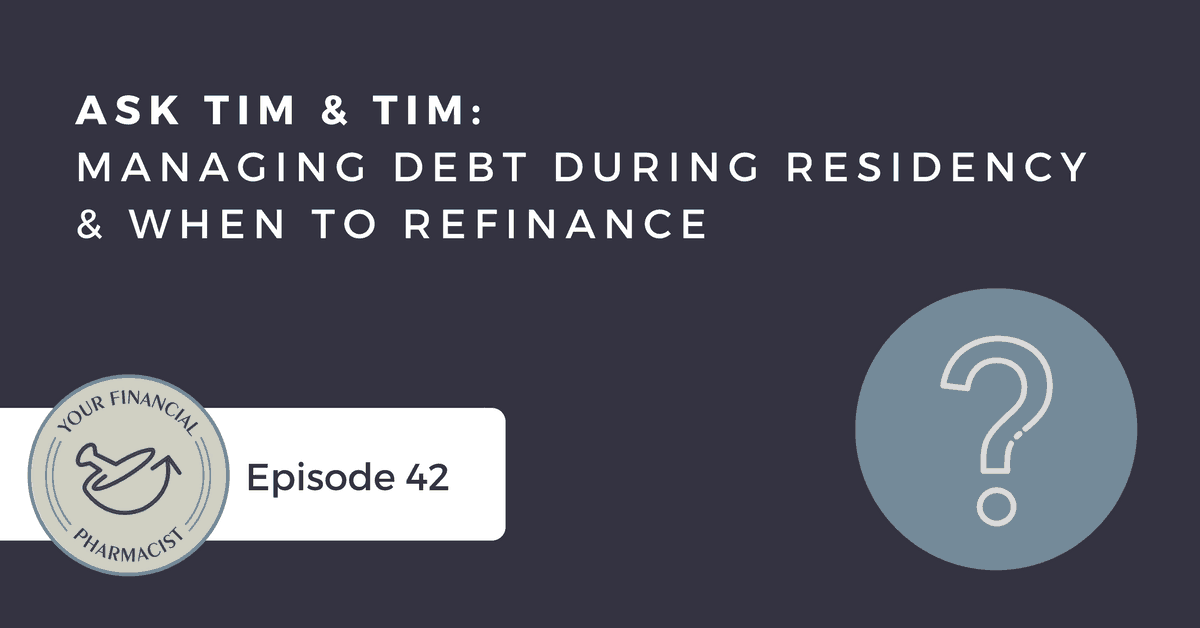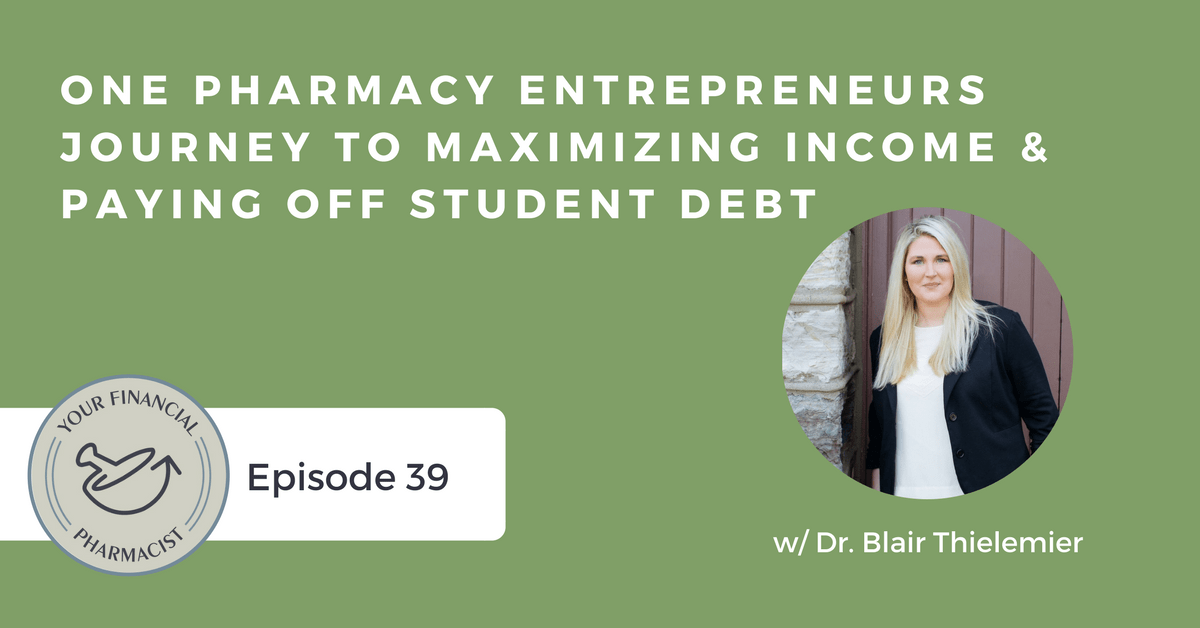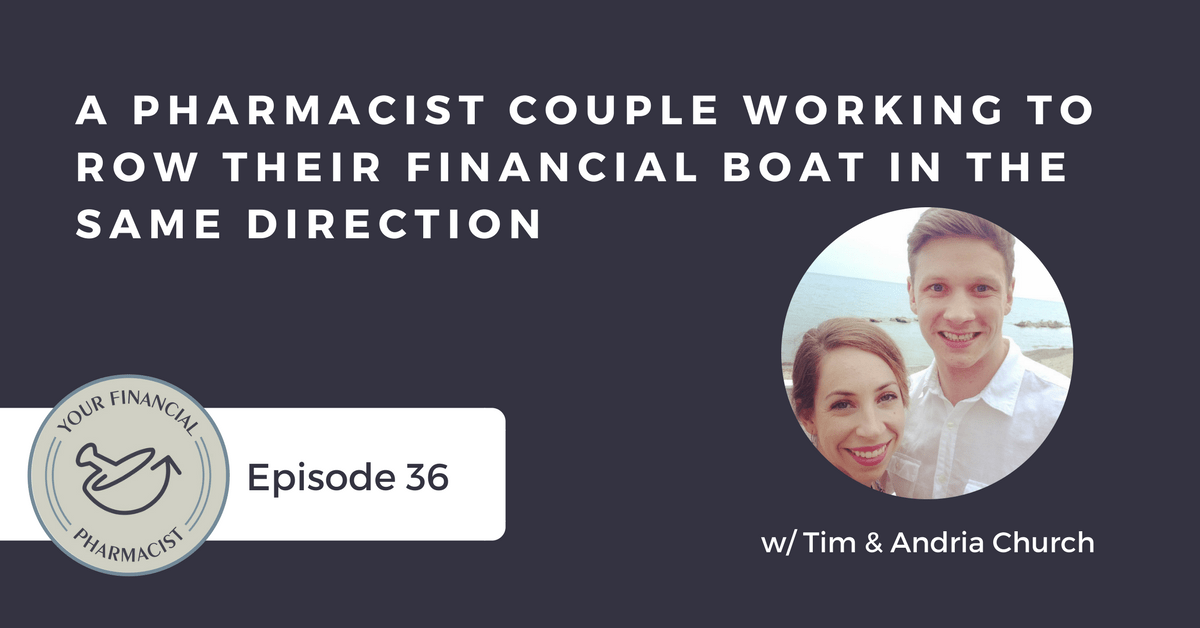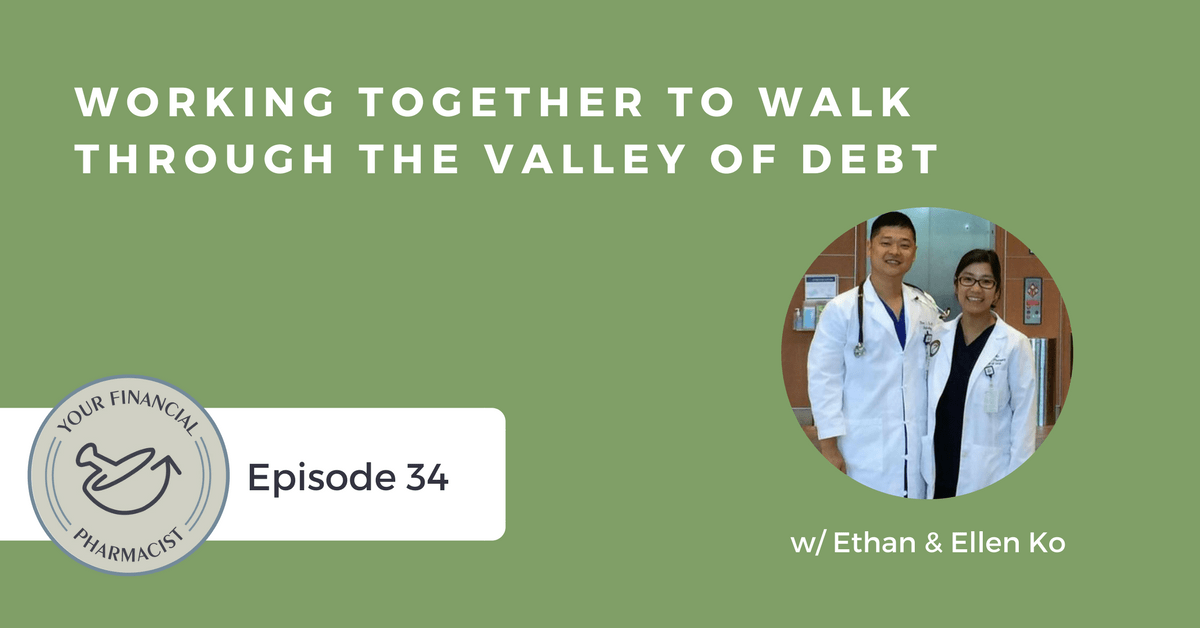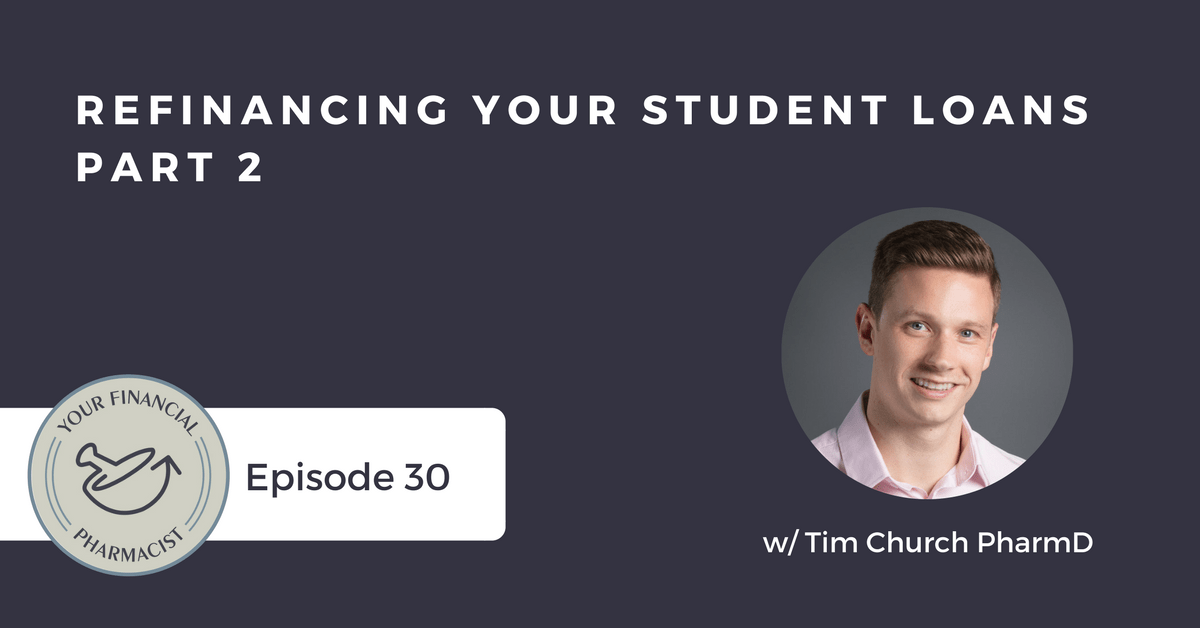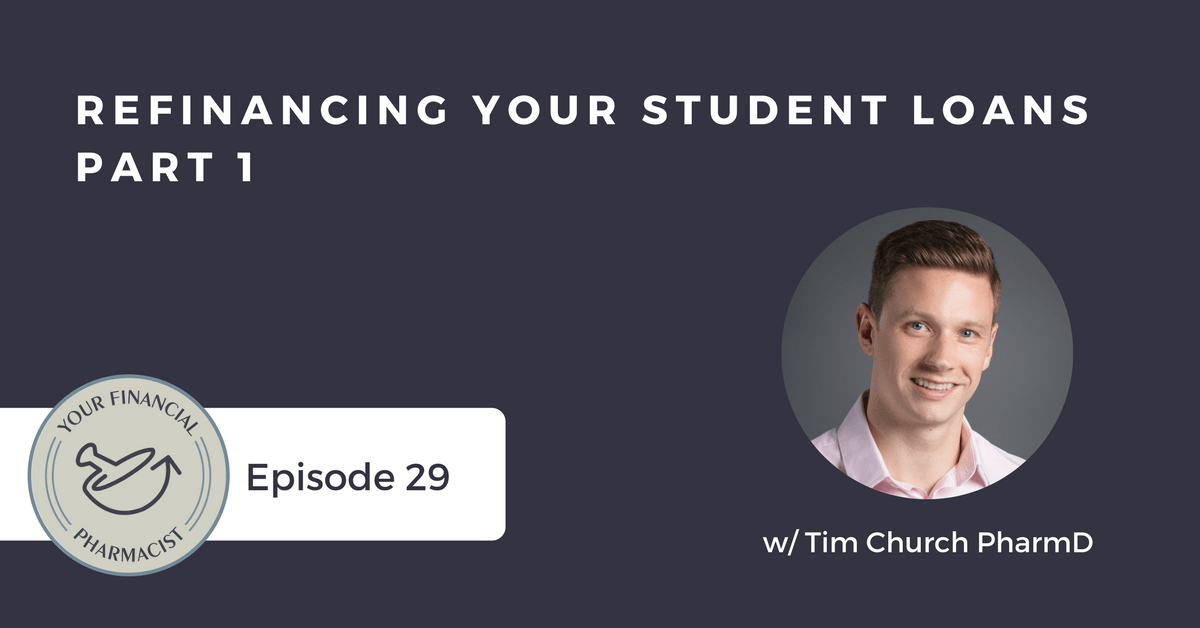On Episode 056 of the Your Financial Pharmacist Podcast, Tim Ulbrich puts Tim Church and Tim Baker on the spot with your student loan questions in a rapid fire format. If you are looking to get started with a game plan to tackle your own student loans, check out the YFP free Student Loan Quick Start Guide at yourfinancialpharmacist.com/studentloanguide
Mentioned on the Show
- YFP Student Loan Quickstart Guide
- Real Estate RPH
- YFP Facebook Group
- YFP Email
- YFP Episode 026: Baby Stepping Your Financial Plan – The 2 Things to Focus On First
- YFP Student Loan Course
- YFP Episode 018: Maximizing the Benefits of Public Service Loan Forgiveness
- YFP Episode 049: Ask Tim & Tim – Should I Pay Off My House Early or Invest?
- YFP Episode 047: Best Practices for Car Buying
- You Need a Budget: The Proven System for Breaking the Paycheck-to-Paycheck Cycle, Getting Out of Debt, and Living the Life You Want by Jesse Mecham
- YFP Episode 031: One Pharmacist’s Journey to Paying Off $211,000 in 26 Months
- YFP Episode 048: Mo Money Mo Problems: Making the Financial Transition to the New Practitioner Life
- Better Business Bureau
- Nerd Wallet
- YFP Episode 029: Refinancing Your Student Loans Part 1
- YFP Episode 030: Refinancing Your Student Loans Part 2
- YFP Student Loan Refinancing Guide and Resources
Episode Transcript
Tim Ulbrich: Hey, what’s up, everybody? Welcome to Episode 056 of the Your Financial Pharmacist podcast. Excited, this is a rarity. Excited to be alongside Tim Baker and Tim Church as we record in-person here as we’re in Rootstown, Ohio for the weekend doing some strategic planning for YFP. We’re excited about all of the excited content and resources we’ve got planned for you for the rest of 2018 and ‘19. So a rarity to have the three of us together. So Tim Church, back here at your roots in Rootstown, Ohio from your time here at NEOMed. How’s it feel to be back?
Tim Church: It feels great. So many changes here at the school. And everything that I got to miss out on once I left, right?
Tim Ulbrich: Absolutely. I mean, we have a Dunkin Donuts now in town. That’s like legit stuff, right? So for those of you that aren’t familiar with NEOMed and Rootstown, Ohio, I think we have three traffic lights, about 7,000 people. So when Dunkin Donuts comes into town, it’s a big deal. And Tim Baker, what’s your takeaway here on Cleveland and some of the things we’ve been doing this weekend?
Tim Baker: Oh, man. I’ve been doing the Tim & Tim tour here. After the Fourth of July, I drove up to Tim Church’s hometown and spent some time with Papa and Mama Church. And they were really nice. And got to see where Tim grew up. We were crushing some work there and then drove down to Rootstown and got to meet, Tim, your boys for the first time, Sam, Everett and Levi, who are awesome, and spend some time with Jess. And great hospitality, but yeah, I’m loving the Tim Ohio tour.
Tim Ulbrich: Yeah, it’s been a ton of fun. And we had a great night last night, shoutout to the RealEstateRPH.com, Nate Hedrick. We had him on previously on the show, and we’re planning some greta content around home buying and real estate and real estate investing. So stay tuned. Throughout the rest of this year and next year, I think we’ve got some really exciting stuff for you. And we’ve heard loud and clear that home buying and real estate investing is a topic that we know that you, the YFP community, are interested in. So stay tuned for some of that coming forward. So here’s the format of what we’re going to do with this episode. I’m going to put Tim Church and Tim Baker on the hot seat. We’ve taken questions the Facebook group, we’ve got questions into our email at [email protected], all questions related to student loans. So we’re going to do a rapid-fire Q&A related to student loans. We’re going to throw out a question, we’re going to answer it quickly and move on. Obviously, if you have other questions, things that we didn’t answer, shoot us an email — [email protected], and if you’re not yet a part of the YFP Facebook group, make sure to head on over there today and to join that community. Alright, Tim Baker, first question from Katrina in our YFP Facebook group. The question is, what’s the best way to balance high student loan balances? I’m talking multiple hundreds of thousands with other financial goals, i.e. savings, investment, retirement, down payment, so on. What are your thoughts?
Tim Baker: Yeah, this is a great question. I think it’s one of the ones we get often. And one of the things I don’t see listed there would be the emergency fund, which I think, you know, we talked about I think in Episode 026, baby stepping into a financial plan, so important to have that there. But you know, Tim and Tim, it’s kind of like one of those things where if a patient comes to you and they’re talking to you about what’s going on in their medical history or their life, it’s hard for you to like give advice without kind of the full picture. So you know, I think it’s hard for me to answer these questions in a silo. But you know, I think really trying to get to the core of what you’re trying to do with your finances and really in life. And there’s a need for prioritization there. Like you have to figure out, OK — because I think what often happens is people come in and speak with me as clients, and they say, I want to do a thousand things. And I’m like, OK, well let’s cut to the core and really focus on one, two, maybe three things to really be zeroes in on. And then knock those goals down and move on. So obviously, a lot of people, you know, student loans are a big thing. So I think it’s kind of taking that inventory of what you have and who you have to pay back, but also the inventory of how you feel about the loans. You know, and comparing that to a lot of these other financial goals that we’re talking about. In the student loan course that we have, you know, we have a strategy specifically for that high debt-to-income ratio and how you should tackle those loans in that situation. And it’s a tough strategy to kind of get to because there are a lot of different moving parts with that in terms of how you optimize that and you know, the whole forgiveness piece and things that are surrounding those programs. So I think ultimately, talk to an objective third party, which could be, you know, a partner, a spouse, maybe a financial planner, and really kind of cut to the core of what is important and how you want to take down the student loans among all of those other goals that were outlined in the question.
Tim Ulbrich: So Tim Church, as I look at Katrina’s question, I can’t help but think, this was really the situation for you and Andrea. So very high student loan balances, and obviously you have other things that you guys want to do — retirement, down payment. But you guys have really chosen — you’re in a renting situation, you’ve really chosen to go all in on your student loans. I mean, what was the thought process there and how did you guys work through to get to that solution to say, hey, we’re not going to really balance all of these things, but we’re going to try to do this one thing and do it really well and get these loans paid off?
Tim Church: Yeah, I think that that’s a great question. And what we kind of thought is yes, it’s going to take us a number of years to really get through all of the loans. So I knew it wasn’t going to be a 2-3 year solution, this is going to be more of around a 4-year+ solution. And given the situation that we were already in, really our two major goals was let’s put some money towards investing and then also be very aggressive with the student loan debt. And so what we’ve been doing is getting the match through our employers and then also maximizing our Health Savings Account because there’s a lot of great options there for tax savings but also the ability to invest what’s in the HSA.
Tim Ulbrich: Awesome. Alright. So Katrina, thank you for question. Second question, Tim Church, comes from Alex via email. I’m currently enrolled in PSLF, however, I only have about $100,000 in debt. Could you provide any insight into when making the minimum payments over 10 years as opposed to aggressively paying them off, such as in three years, ends up being similar. What are your thoughts there?
Tim Church: So first off, I think this is a really cool situation to be in because you have student loan debt that’s less than a typical pharmacist would. You know, we look at the average is around $160,000 and even higher for those who went to private institutions. So first off, that’s pretty cool to be in that situation. I think the other question you have to ask in this situation is what is your goal? And do you really want to have student loans around for 10 years, even if you’re going into the program versus kind of knocking those out and moving on with your life. What’s interesting is that if you look a three-year versus a 10-year PSLF, the total amount that’s actually paid ends up being fairly similar when you do some basic surface calculations. So if you make payments based on your adjusted gross income over 10 years versus paying really aggressively over those three years. So it’s about $2,000 or more difference that you’re going to pay extra if you want to knock them out in three years. And so that could be very attractive to say, hey, my student loan debt’s done. It’s out of my life, I can move on. But you also have to look out, OK, what would be the benefits of doing PSLF and going that route. And so if you look at on a surface level, you could say, OK, the overall payout could be similar, but are there things that you could do to lower your adjusted gross income? And so we talked on Episode 018 about maximizing the benefits of PSLF, and we really go into where you can contribute to your 401k, you can contribute to an HSA and do some other things that actually lower your AGI so your total amount that you’re going to pay over that 10 years could be a lot less than if you did nothing to sort of do that. So I think it’s very interesting, and there’s a lot of calculations from a math standpoint to say, what is the actual difference? But I think you have to really add in those emotions as well. So I don’t think there’s really a clear answer to this. And a lot of times, we’re seeing people that have very high debt loads where it kind of points people to say, wow, PSLF definitely is the better choice and there’s a lot more savings that’s there.
Tim Ulbrich: OK, so our next question comes from Jordan via email. After graduating from pharmacy school in May 2017 with $265,000 in loans, I’ve been working tirelessly for the past nine months at two hospitals and saving tremendously. Currently, I’ve saved over $90,000 to pay for future expenses such as a house or car. My student loans are through the PSLF program and are fairly cheap in regards to my monthly income. I’m curious to your thoughts on paying for a house or car in cash in the future or continuing to save in case the program falls through. So Tim Baker, what are your thoughts on this one?
Tim Baker: Yeah. I love this question because I love that this particular person, Jordan, that you didn’t kind of buy into the whole, hey, we’re pharmacists, we make good incomes and kind of resting on your laurels. Obviously, you’ve been hustling. I think that’s a great thing. I think with regards to this question, again, I’m looking at it from kind of the lens of a financial planner and looking at the big picture. You know, I see $90,000 in liquid assets, you know, maybe some financial planners would say, invest all of that. Again, that kind of goes back to the question that we had from Michael in Ohio about follow the money. But I think, again, it all goes back to goals. What is the goal here? Is it to maximize the amount that’s forgiven? Is it to get out from underneath the loans as quickly as possible? Is it to minimize what you’re financing between a house and a car? So I think those are super important. To me, I think the exercise from there is to really earmark that $90,000 at present and really going forward, for those particular goals. So if it’s to peel away $60,000 for a down payment on a house — and I think as a team, we believe a 20% down payment is best practice to avoid PMI and really have a decent equitable stake in your home, is I think the best thing for the balance sheet in home buying. I think cash can be king, especially if you’re in a competitive market. Maybe you earmark another portion of that towards a car, and I think referencing Episode 047, Best Practices for Car Buying, which Tim Ulbrich did, I think would be a great place to start there and really not, you know, let some of those dollars evaporate in that transaction I think is important. But I think also, one of the things that, you know, for the question kind of pertaining to PSLF and its longevity, you know, I think from — and this is kind of my opinion — is that I think that the PSLF program, it does have legs. Meaning I think with some of the things that are going on in Congress and earmarking dollars for kind of the PSLF mishaps, which, you know, have been documented quite a bit in the news. I think that at the very least, if we decide, if the government decides, hey, this isn’t a program going forward, they would at least grandfather you in. But again, that is me. And I’m not the one basically making the budget decisions. But I think with that money, if that were a concern — and again, this is also something that we talk about in the student loan course — is maybe you earmark part of that money and then contributions going forward into a fund that can kind of offset that, that is kind of like a rainy day fund in case the PSLF program, you know, falls through. So that would — again, it kind of goes back to the goals and really parsing those out and trying to figure out the best way to deploy those liquid assets that you’ve accumulated, you know, very aggressively and then to have a plan for that going forward in terms of where are you going to contribute that. And I’m a big proponent of basically segmenting those things out, whether it’s a car fund, a home fund, an index fund for, you know, your rainy day PSLF falls through scenario. So that’s kind of where I would start.
Tim Ulbrich: Yeah, and just to kind of shoutout to Jordan, to do the work to save up $90,000 in cash, thinking about some of these strategic things around house or car or being ready if PSLF were to fall through, that’s no small feat. And obviously, in the question, he references hustling for the last nine months, working two hospital jobs, so good work, Jordan. Obviously, you’ve got a student loan situation that you’re trying to get out in front of. But certainly it appears like the work ethic is there, and the future is going to be bright. So Tim Church, Jessica from the Facebook group says, if loans are still deferred while still in school, is it worth paying on the interest? What is the best strategy?
Tim Church: So I think the answer is maybe, but likely yes. So if you look at federal loans, which typically have interest rates of 6-8% and if we’re talking graduate school loans or professional school loans, these are going to be, by and far, they’re going to be unsubsidized loans, which means the second that those loans are activated, are dispersed, every day, interest is accumulating on those loans while you’re in school. So it just keeps building and building and building, and eventually will capitalize once you are post-grace period. And so I think that anything you can do to first off minimize the debt in the first place in the amount that you’re going to take, it is something that you should do. But then yeah, if you get access to other funds or find opportunities, then of course, making those kind of payments are going to help reduce that interest that’s going to eventually capitalize. Now, the one caveat with that is that if you feel that you’re going to be pursuing PSLF or even non-PSLF forgiveness, then it may not make as much sense to actually put extra money towards the loans because the reality is is that if you’re all-in on one of those programs, you want to minimize that you actually are going to pay out-of-pocket over time. And that’s just the way to maximize the effectiveness of the program. And so, if that was your strategy, any additional income or funds actually may be going towards investments or some of your other goals that you’re going to pursue and then just sort of after that grace period, you’re going to figure out ways how you actually minimize those student loan payments. And I think a lot of people may be in the grace period right now, we just had a lot of pharmacy graduates complete their PharmD program. And I think it’s so important that you have some sort of game plan in place because right now, all of that interest is getting ready to capitalize once that grace period ends. And so having a strong game plan and knowing exactly what you’re going to do and how you’re going to attack your loans is so important. You know, because Tim Ulbrich, you and I, we talked about how a lot of mistakes that we made just because we didn’t have a game plan right from the get-go, and we kind of had to learn from some of the mistakes that we made. But I think we do such a great job in the student loan course to just really helping you get a strategy in place and feel comfortable about it, but then really taking it to the next level to make sure that you are getting the most savings. So if you’re interested in checking that out, you can go to YourFinancialPharmacist.com/student-loan-course.
Tim Ulbrich: Yeah, I couldn’t agree more, Tim Church, about being intentional in this period. And you know, putting myself back in the shoes of graduation comes, there’s that excitement around graduation, you’re thinking about trying to pass the NAPLEX and the MPJE, maybe you’re starting residency. If not, you’re starting your job. And I think in that time period, there’s so many pieces and parts and moving things that are going on that it’s easy to just wander through that and all of a sudden, you get that notification for first payment, and you’re like, what am I actually going to do, right? We’ve got all these federal options, we’ve got refinance, forgiveness or not, and so I think really being intentional in this period — residency, no residency, doesn’t matter — new grads of saying what’s the one best repayment option and strategy for my personal situation? And as Tim Church mentioned, I think we do a great job of that inside the student loan course at YourFinancialPharmacist.com/student-loan-course. OK, Tim Baker, question from Miranda in the Facebook group — and I might be setting you up for failure to try to answer this depth of a question in a rapid-fire format, and we’ve talked about this before in terms of balancing investments with paying off student loans — but Miranda says, with talking to my preceptors, a lot of them recommend paying yourself first or saving. Being a numbers person, I’d be interested in learning a formula for what percentage of income should be dedicated to savings, emergency fund, the loans, expenses, etc. What are your thoughts?
Tim Baker: Oh man, this is such a tough one. And I hope listeners are not getting upset with me because I’m not giving like this is what you should do, and technically, I can’t do that. It’s so hard because, you know, I think people want to know like where do I fit compared to like — what am I spending on my cat or dining out versus like the norm of what you see? And I kind of have those ideas in my mind, but if you’re at a different stage of life, took more of a nontraditional route through school, I mean, it could be completely different. So you know, I actually just got done reading the book, “You Need a Budget,” which is written by — I think his name is Jesse Mecham, which is the You Need a Budget founder, which is kind of a budgeting tool that rivals Mint. And you know, he kind of echoes this same point is that, again, there is no cookie cutter solution to this. Everyone is going to be a lot different than the next person over, even it could be in similar situations. So I think, you know, for me, if I could kind of look very strategically and high level at a case, it’s obviously, again, it’s like, what are the goals? What are the feelings towards the debt? And then beyond that — you know, I think that drives the train a lot — but then beyond that, it’s like, make sure you have that emergency fund. And it could be kind of like a base-level emergency fund, so maybe $1,000 covers a lot. Most emergency funds, if there are emergency situations if you’re single, it’s $5,000. But then you know, building upon that, but then beyond that, make sure you’re absolutely getting the match from your employer and then get that free money. But from there, it’s kind of like a choose-your-own adventure. And again, I think that’s where kind of peeling back some of the layers of what’s important is so vital because it’s really going to drive your decisions. And I think it’s easier to kind of adhere to a plan when you say, OK, I am doing this because of y in the future. And I think those high-level things are make sure the consumer debt is taken care of, make sure you have an adequate — and I put “adequate” in air quotes — emergency fund that you feel comfortable with because the textbook is going to say 3-6 months of those non-discretionary monthly expenses, so if you have rent of $2,000 and a loan payment of $2,000, that’s $4,000 right there just in that, you know, and if you’re single, times that by 6. So that’s pretty substantial. But I think, again, this is why stepping into it and being intentional about this, there is no percentage. But I can — if I look at your situation, I can tell you, yeah, that is high and maybe cut back or — again, the other piece of this is how can you grow your income? How can you look at Jordan’s situation and hustle and elbow grease. And you look at the Patterson episode with Adam and Brittany Patterson just crushing their debt because of like the extra shifts, so yeah, there’s a lot of nuances, and I hope some of that helps. But there is no cookie cutter; there is no right answer.
Tim Ulbrich: Good stuff. So Tim Church, Dalton from the Facebook group — and Dalton, we had on Episode 048, Mo’ Money Mo’ Problems — Making the Financial Transition into the New Practitioner Life, if you haven’t yet checked out that episode — he has a question around refinancing. What should I look for in a refinancing company such as if they have prepayment penalties? And so when I think refinance expert, I think Tim Church. So talk us through what people should be looking at when it comes to refinancing.
Tim Church: Yeah, so I think there’s so many different companies out there, and it’s a very crowded space. And so a lot of people, they’re spending a lot of money to market to people, especially pharmacists who have large debt loads to get you to refinance your loans. So there’s definitely some things you want to be looking out for to make sure you protect yourself. And especially because there’s been a lot of scams around consolidation companies and people thought they were with reputable companies, but the reality was that they were defrauding people. And so you have to protect yourself. So a couple ways to look at that to make sure is the Better Business Bureau to check them out to make sure that the company is No. 1, that they’re legit and that they don’t have substantial complaints against them and making sure that you’re comfortable with a lot of those reviews and the rating that they’re giving them. NerdWallet actually has something called a watch list where they’re putting any companies with very shady business practices or have lawsuits against them on a database, so I think that’s another place to check. So if you’ve never heard of the company before, those are probably things you want to check out for. Some other things that I think are really important — there really should be no fee for you to refinance your loans. They’re actually competing for your business, and they actually — what they’re doing is giving you money to come over to them and to be part of their community and their program. So they actually offer cash bonuses to you, but there should be no fee that you’re actually paying. The other thing I think is important is that there’s no prepayment penalty. So if you say that you’re going to refinance for a term of five years, seven years or 10 years, but you want to pay that off faster, then there should be no penalty for you. Now, obviously, the way that they make their money is at the interest that you pay each and every month. And so if you pay off your loans faster, obviously they’re going to get less money than intended originally. But most companies, I haven’t seen any issues with this that they have no special clauses or anything, so you’re going to be OK for the most part if you want to pay it off faster than the term. So some of the other things that you want to look out for — now, obviously if you’re pursuing any of the forgiveness programs, you do not want to refinance because you’re going to automatically disqualify yourself for any of those programs. You have to keep your loans in the federal system. And then the other thing, a lot of people, they talk about when you move your loans out of the federal system into a refinance company that you’re losing all of those protections. And the idea is that yes, is that there are some things that you’re not going to get, and that’s going to be income-based repayments for the most part. So if something happens to your income, and you can’t make that monthly payment, and you have to go down to some small payment or you want to put it in deferment or forbearance, that may not be offered by a refinance company, so it’s something that you want to look out for. And then the other things is that loans within the federal system will be discharged if you die or become permanently disabled. Well, that’s not the case for every refinance company, but there are some that still have that protection. So something just to keep in mind if you have strong policies in place that may not be as much of a concern to you but something that you still want to take a look at.
Tim Ulbrich: Good stuff. So 29 and 30, episodes 029 and 030, Refinancing Student Loans Part 1 and Part 2, we talked a lot about that topic, so if you’re a listener who’s thinking, is refinancing for me? Is it not for me? Who should do it? Who should not do it? What does that even mean? Head on over and check out episodes 029 and 030. And we’ve also built out a great refinance resource page at YourFinancialPharmacist.com/refinance where we have a guide that can walk you through a lot of what Tim Church just talked through, making sure you’re really answering the question, who is refinancing for? Is it right for me or is it not? And then ultimately, start to get some quotes and get the cash bonus if you were to pursue that in the future. So again, that’s YourFinancialPharmacist.com/refinance. So Tim and Tim, great stuff, thank you so much for coming on, excited that we could do this in person. We’re hoping to do much more of this in the future. And again, if you are hearing these questions around student loans and you’re trying to think where should I get started? Check out the YFP free student loan quick start guide at YourFinancialPharmacist.com/student-loan-guide. Again, that’s YourFinancialPharmacist.com/studen-loan-guide. And if you have a question that you would like to have answered on a future episode of the YFP podcast, send us an email at [email protected]. That’s all for today’s episode. Have a great rest of your week.
Join the YFP Community!
Recent Posts
[pt_view id=”f651872qnv”]

